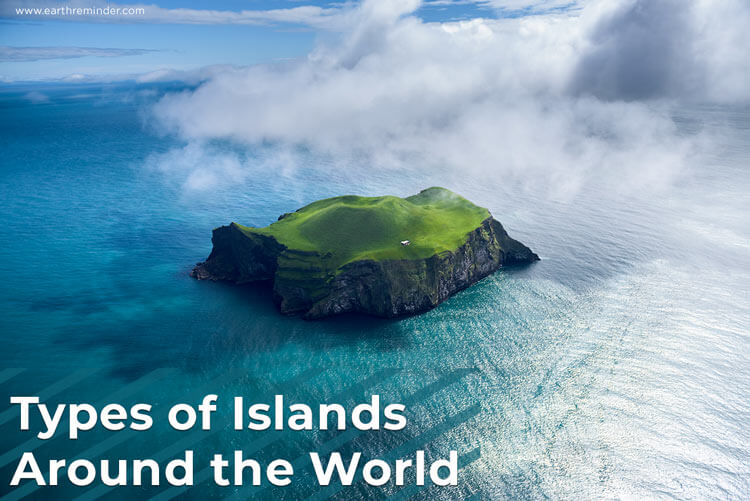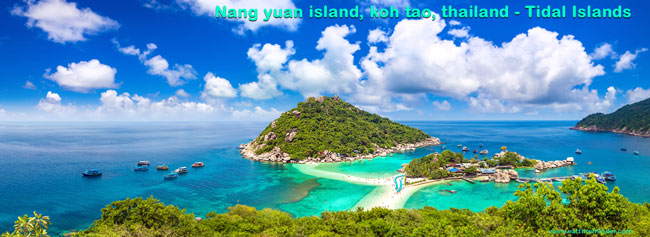Types of Islands around the world
Generally, we consider a landform entirely covered by water as an Island. Islands are smaller than continents that may be found in oceans, seas, rivers, or lakes. Now you may think continents are also surrounded by water like islands, then why we use two different terms for both.
Well, from the geographical point of view, the only difference between an island and a continent is the size. The continents have huge comparative landmasses, whereas islands own smaller areas of land. Hence, we do not consider the islands as continents.
We know Australia as the smallest continent, and Greenland is the largest island in the world. Australia is almost three-times bigger than Greenland. Many islands vary from each other in their size, climate, habitat, and biodiversity.
Table of Contents
Different Types of Islands Around the World
Different kinds of islands exist on the planet. There are six major types of islands. These are Continental, Oceanic, Barrier, Tidal, Coral, and Artificial islands.
Continental Islands
We can recognize continental islands from its name itself. A continental island was connected to a continent at some point. These types of islands sit on the continental shelf. Continental islands are land masses that have been separated from the continents by shifting of tectonic plates to form an island.
According to scientists, there was only one huge landmass that is Pangaea. Over a while, Earth’s crust movements caused the breaking of the crust into many pieces. Thus, they drifted apart. These kinds of tectonic activities led to the formation of different continents and continental islands of the globe. Greenland and Madagascar are ideal examples of continental islands formed through this process.
Oceanic Islands
We also know oceanic islands as volcanic islands. This is because volcanic eruptions on the ocean floor form them.
Volcanic eruptions in the ocean floors accumulate many layers of lava. This eventually emerged above the water surface in the form of an island.
From many types of islands around the world, we can also describe oceanic islands as high islands. Further, Continental and coral islands are known as low-lands, even if they are hundreds of meters taller than high islands.
Different volcanoes involved in the formation process of these islands. For example-
- Some oceanic islands are formed in the subduction zone. This is a zone where one tectonic plate is shifting under another. For example- the island nations of Japan exist at the site of four tectonic plates.
- Some other types of oceanic islands form when the tectonic plates split away from one another. For example- the island of Surtsey formed in 1963 when the Eurasian tectonic plate drifts apart from the North American plate.
- Oceanic islands also form when a continent shift over a hot spot. A hot spot is basically a break in the Earth’s crust where material from the mantle comes out to make an island. For example- islands of the U.S. state of Hawaii are formed through a single hot spot over millions of years.
Barrier Islands
These are the narrow islands that exist parallel to the coastline. This separates the mainland from the ocean. As the name suggests, these help to protect the coastline from oceanic storms and waves.
Barrier islands are formed in shallow-water regions composed of sediments, mainly sand. Lagoons or a sound separates the islands from the mainland. The various processes involve the formation of barrier islands. For example:
- Some sediments like sand, silt, and gravels take part in the formation of barrier islands. For instance- islands of the Atlantic coast of Southern Florida.
- Some other kinds of barrier islands exist. Yet, billions of tiny coral exoskeletons form them.
- Accumulated sand where ocean currents pile up sand on sandbars creates some other barrier islands. Eventually, these sandbars rose above the water surface and appeared like an island.
- Glacier depositions from the ice age also take part in the formation of some barrier islands. For example- Glacier moraines formed the long Island in New York & Nantucket off the coast of Massachusetts.
Tidal Islands
This is a kind of island that majorly depends on a tidal action for its existence. It means tidal islands are landforms that are more visible at low tides but submerged during high tidal actions.
The tidal islands are a kind of continental islands. During high tidal actions, it seems like the connecting land has been completely eroded from the island. But high tides submerge them deep underwater.
These are a very common type of islands in the world. For example- Jindo & Mondo Island in South Korea, Cramond Island in Scotland, Mont Saint-Michel Island in France, etc.
Coral Islands
Coral islands are one of the most beautiful types of islands around the world. Low flat landforms formed in warm waters by small sea creatures, i.e. corals are known as coral islands. Coral islands occur in tropical & subtropical regions across the world. The corals build up a hard skeleton which comprises limestone, i.e., calcium carbonate. The external skeleton of the corals is like the shells of other sea creatures, like clams, mussels, etc.
Some coral reefs may grow up from a plateau on the seabed until they emerge above the water surface, creating a coral island. For example- the islands of the Bahamas in the Atlantic Ocean & Caribbean Sea are the highest parts of underwater banks.
“Atoll” is another type of coral island. It is a coral reef that starts originating in a ring form around the sides of an oceanic island. As the island or volcano slowly sinks into the water surface, the reef keeps on growing continuously. For example- Lakshadweep islands, India comprises 12 such atolls.
Artificial Islands
Humans create these types of islands using material like sand, rocks, etc. for various purposes as tourist attraction sites. To create an artificial island, we might establish a new site using material brought from other regions. For example- Dubai waterfront where deposition sand was dredged from the Persian Gulf on the sea near Dubai shores.
Further, we create some artificial islands where the only existing island is expanded or changed to make it more attractive. For example- the Vasilyevsky Island was extended westward for about 0.5 km distance during the construction of the St. Petersburg Passenger Port.
Many islands in the world vary their size, habitat, and biodiversity. Now, the universe is facing various environmental problems, then how can the islands remain untouched?
Thus, we should focus on controlling ecological issues such as pollution, greenhouse effects, global warming, and so on. It is very crucial to protect the amazing creations of nature, i.e. islands and biodiversity that belong to these islands.

